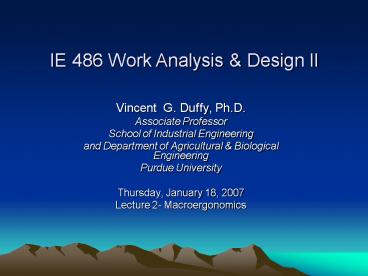IE 486 Work Analysis PowerPoint PPT Presentation
Title: IE 486 Work Analysis
1
IE 486 Work Analysis Design II
- Vincent G. Duffy, Ph.D.
- Associate Professor
- School of Industrial Engineering
- and Department of Agricultural Biological
Engineering - Purdue University
- Thursday, January 18, 2007
- Lecture 2- Macroergonomics
2
IE 486 Administrative
- Wickens text on reserve electronic version (full
version) of Freivalds text is also in library
catalog - Re CPS Clickers well use them in Feb.
- Today ch.19
- Next week ch.6 7 in Wickens
- Lab schedules revised show today
- Times include sections on Friday 830, 1030,
130 and 330.
3
Macroergonomics
- The chapter we will refer to is Ch. 19 in Wickens
(titled Social Factors) - The chapter is comprised of key elements among
the social AND organizational factors - Macroergonomics addresses the social and
organizational aspects
4
Social factors
- Ch.19 in Wickens
- impact of groups and teams on performance
- how technology supports groups and teams
- Why care about groups and teams in Work Analysis
Design? - Individuals vary with respect to performance and
error - So do teams
- Consider
- Performance, task/goals, people/team
characteristics capabilities and limitations
5
Social factors
- QOTD Q.1. Why care about groups and teams in Work
Analysis Design? - Individuals vary with respect to performance and
error - So do teams
- Besides system/technology characteristics
- Consider also
- Performance, task/goals, people/team
characteristics capabilities and limitations
6
Characteristics of teams
- All teams are groups, but not all groups are
teams - teams tend to have the following characteristics
- group perceived as a work unit by members
non-members - interdependence (reliance on one another) and
shared outcome - role differentiation
- interdependent relations with other groups
7
Team performance
- In a complex, dynamic environment with safety
considerations, communication and job performance
typically decline - Communication has a strong impact on performance
(see also p.499 in 2nd ed.)
8
Team training
- Emphasizes the acquisition of team skills
- Computers/specialized software can support
communication and coordination - see also groupware p.500 2nd ed.
- they can
- provide anonymity
- impose structure on the process
- provide workspace for ideas or writing
- reduce disapproval and counterproductive
behavior such as minority exercising authority
and control
9
Decision and communication support systems
- Decision support can increase confidence in
decisions - Communication support can decrease domination of
the group by a few - however, communication support also can decrease
overall cooperation and consensus building - (see also refs. By Nunamaker, Az.State).
- Collocated teams outperform distributed teams
- reducing visual access significantly impacts
group dynamics (p.604 1st ed.)
10
Difficulties in remote collaboration
- Whether advances in technology can overcome the
disadvantages of distance collaboration is not
clear. (p.503, 2nd ed.)
11
Organizational factors
- Microergonomics - focus on individual workers
- Macro ergonomics - address performance and safety
at the social and organizational levels - rather than only the physical and cognitive
levels. - Why is it needed?
- In understanding accidents in high-hazard
industries decisions must be understood in
context p.503-504, 2nd ed.
12
Organizational change - barriers
- Barriers
- Training may be costly
- stockholders would prefer pay dividends rather
than reinvest in the company - managers may lose power and authority
- many people naturally resist change
- reward structures typically dont support
change - employee participation (participatory ergonomics)
can help to overcome these barriers (p.504) - As is shown in recent literature on user access
for all-Social and intranets organizational
learning, more research is needed
13
Types of systems
- Described in relation to degree of complexity and
coupling - These are dimensions affecting performance and
safety - Degree of complexity and coupling has
implications for the likelihood of catastrophic
failure - Highly complex, tightly coupled systems are
vulnerable to catastrophic failure - Work design specialists may study events leading
to failures at Chernobyl, Three mile island,
Challenger, now Katrina - Considering the team/organizational aspects
14
Types of systems
- Complexity refers to the number of feedback
loops, interconnected subsystems and invisible
unexpected interactions - Nuclear power and petrochemical plants are
complex behavior of one subsystem may affect
many others, and these interactions can be
perceived only indirectly - Coupling refers to the degree that there is
little slack and a tight connection between
subsystems - Tightly coupled system examples just-in-time
supply chain a disruption in part system
quickly affects other parts of the system
15
Types of systems
- Combinations and System characteristics
- (See table 19.1 on p.493).
- Q.2 What are examples of each?
- High Complexity Low Coupling
- Low Complexity Low Coupling
- High Complexity High Coupling
- Low Complexity High Coupling
16
Types of systems
- Combinations and System characteristics
- Q.2 What are examples of each?
- High Complexity Low Coupling
- Universities, Government
- Low Complexity Low Coupling
- Traditional manufacturing
- High Complexity High Coupling
- Nuclear power, Airplane, air travel
- Low Complexity High Coupling
- Marine transport, rail transport, JIT Supply
chains

